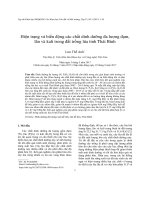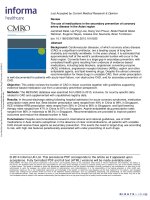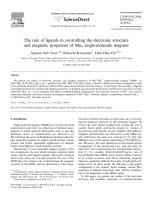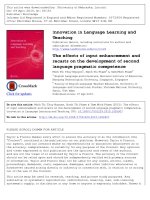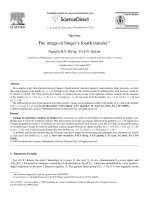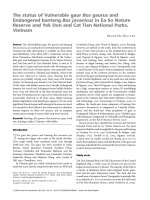DSpace at VNU: The status of Vulnerable gaur Bos gaurus and Endangered banteng Bos javanicus in Ea So Nature Reserve and Yok Don and Cat Tien National Parks, Vietnam
Bạn đang xem bản rút gọn của tài liệu. Xem và tải ngay bản đầy đủ của tài liệu tại đây (197.97 KB, 7 trang )
The status of Vulnerable gaur Bos gaurus and
Endangered banteng Bos javanicus in Ea So Nature
Reserve and Yok Don and Cat Tien National Parks,
Vietnam
Manh Ha Nguyen
Abstract The wild buffaloes, gaur Bos gaurus and banteng
Bos javanicus, are among the most threatened mammals in
Vietnam but little information is available on their status
and distribution. Over 2004–2007 I undertook surveys in
three Vietnamese distribution strongholds of the Vulnerable gaur and Endangered banteng: Ea So Nature Reserve
and Yok Don and Cat Tien National Parks. A total of 22
herds with 121 gaur and seven herds with 49 banteng were
observed. Herd sizes of both species were generally lower
than those recorded in Thailand and Malaysia. Most of the
herds were observed in remote areas, showing that the
species are probably staying away from areas with human
activity. No banteng were found in Cat Tien National Park.
Of the other wild buffalo species the Critically Endangered
kouprey Bos sauveli and Endangered water buffalo Bubalus
arnee were not observed in the three protected areas but
the Near Threatened serow Capricornis milneedwardsii was
occasionally observed in all three areas. Illegal hunting,
habitat degradation and disturbance appear to be the most
significant threats to gaur and banteng in the areas surveyed.
It is essential to have effective law enforcement to eliminate
human impacts on these two species, and an adequate
conservation strategy to secure their long-term survival.
Keywords Banteng, Bos gaurus, Bos javanicus, gaur, herd
size, hunting, trophy, Vietnam, wild buffalo.
Introduction
T
he gaur Bos gaurus and banteng Bos javanicus are
among the largest wild cattle of the family Bovidae.
They range widely from mainland South Asia through
South-east Asia. The gaur has been recorded in India,
Bhutan, Nepal, Myanmar, Thailand, Southern China,
Vietnam, Cambodia and Peninsular Malaysia, and the
banteng in Myanmar, Thailand, Laos, Cambodia, Vietnam,
Indonesia, Brunei and Malaysia (Dang, 1986; Corbet &
Hill, 1992; Choudhury, 2002).
In Vietnam gaur are widely distributed from north to
south but occur mainly along the border with Lao PDR and
M ANH HA NGUYEN Centre for Natural Resources and Environmental
Studies, Vietnam National University, 19 Le Thanh Tong Street, Hanoi,
Vietnam. E-mail
Received 12 March 2007. Revision requested 29 May 2007.
Accepted 29 November 2007.
Cambodia (Dang, 1986; Thach & Nguyen, 2005). Banteng,
however, are limited to the south, from the northernmost
areas of Kon Tum province to the southernmost parts of
Binh Phuoc province (Dang, 1986; Duckworth & Hedges,
1998; Nguyen & Nguyen, 2005; Thach & Nguyen, 2005).
Gaur and banteng have declined in Vietnam, mostly
because of illegal hunting and habitat loss (Dang, 1986;
Le et al., 1997; Nguyen & Nguyen, 2005). Consequently, only
a small fraction of the gaur’s former population remains in
isolated areas of the northern provinces. In the southern
provinces the gaur and banteng remain in some remote areas
in the Central Highlands, and in the south-east and border
provinces (Dang, 1986; Duckworth & Hedges, 1998; Nguyen
& Nguyen, 2005; Thach & Nguyen, 2005). Gaur and banteng
are a high conservation priority in Annex IB (prohibiting
exploitation and utilization) of the Government’s wildlife
protection decree. Both species are categorized as Endangered in the Vietnam Red Data Book (Ministry of Science
and Technology, 2007; Government of Vietnam, 2006). In
addition, the South-east Asian subspecies of banteng (Bos
javanicus birmanicus) is categorized as Critically Endangered, and the South-east Asian population of gaur as
Endangered (Heinen & Srikosamatara, 1995). Globally, gaur
and banteng are categorized as Vulnerable and Endangered,
respectively, on the IUCN Red List (IUCN, 2007).
Recent surveys have clarified that Cat Tien and Yok Don
National Parks and Ea So Nature Reserve are the most
important habitats and strongholds for the gaur and banteng
in Vietnam (Le et al., 1997; Duckworth & Hedges, 1998;
Murphy, 2004; Tordoff et al., 2004; Nguyen 2006a,b).
I report here on studies carried out during 2004–2007 to
assess the population status and distribution of the gaur and
banteng, and identify the continued threats to their existence
in these three protected areas.
Study areas
Yok Don National Park is in Dak Lak province of the Central
Highlands (Fig. 1). With 115,545 ha of total core area it is the
largest protected area in Vietnam. The majority of the Park is
a mosaic of deciduous forest, semi-evergreen forest, grassland and dry-open dipterocarp forest. The Park also has
a small area of evergreen forest. Topography is generally flat,
at an altitude of c. 200 m, but there are some low hills such
as Yok Don Mountain (Anon., 1998a; Tordoff et al., 2004).
ª 2009 Fauna & Flora International, Oryx, 43(1), 129–135 doi:10.1017/S0030605307000440
Printed in the United Kingdom
130
M. H. Nguyen
FIG. 1 Location of Ea So Nature Reserve and Yok Don and Cat Tien National Parks. The inset indicates the location of the main figure
in Vietnam.
The 22,000 ha Ea So Nature Reserve is in Dak Lak
province of the Central Highlands (Fig. 1). The Reserve
contains evergreen, semi-evergreen and deciduous forests.
Within the forest are large areas of grassland that provide an
important habitat for large mammals, particularly wild cattle
(Le et al., 1997; Tordoff et al., 2004). Topography is almost
flat in the east, and there are relatively steep hills in the southwest and west. Altitude ranges from 140 m in the valley of the
Ea Puich stream to 1,046 m on the Chu Ble Ya mountain
range (Anon., 1998b; Tordoff et al., 2004).
The 70,548 ha Cat Tien National Park, among the largest
protected areas in Vietnam, is in Lam Dong, Dong Nai and
Binh Phuoc provinces, in the south-east (Fig. 1). The Park
connects to five State Forest Enterprises (Ma Da,Vinh An,
La Nga, Bu Dang and Nghia Trung), forming a large complex
of lowland forest (.100,000 ha) that is the most important
habitat for animals, including wild cattle, in this area (Cat Tien
National Park, 2003; Murphy, 2004; Nguyen, 2006a). The Park
is divided into two sectors: Cat Loc (Lam Dong province) and
Nam Cat Tien-Tay Cat Tien (Binh Phuoc and Dong Nai
provinces). The Park comprises primary and secondary
lowland evergreen and semi-evergreen forests, freshwater
wetlands with open lakes and seasonally inundated grasslands, and bamboo forest. The topography of the park varies
greatly between the sectors. The Cat Loc sector is at the
southern extent of the Central Highlands, and is a mostly
mountainous area with relatively steep hills (maximum
altitude 659 m). The Cat Tien sector is in the southern lowlands, and is characterized by low hills (maximum altitude
372 m; Cat Tien National Park, 2003; Tordoff et al., 2004).
Methods
Interviews A total of 25 forest rangers and technical officers
and 32 local people in four communes in Cat Tien, two
communes in Ea So and two communes in Yok Don were
interviewed for information on wild cattle.
Secondary data Information on previous records of wild
cattle was gathered from reports and other publications
dating from 1989 onwards (Table 1).
ª 2009 Fauna & Flora International, Oryx, 43(1), 129–135
Decline of wild cattle in Vietnam
TABLE 1 Previous gaur and banteng records in Ea So Nature Reserve and Yok Don and Cat Tien National Parks (Fig. 1).
Reference
Ea So Nature Reserve
Le et al., 1997
Gaur Bos gaurus
Banteng Bos javanicus
Main methods used
At least 8 individuals
At least 17 individuals
Anon., 1998b
Presence confirmed
Presence confirmed
Duckworth & Hedges, 1998
Tordoff et al., 2004
Yok Don National Park
Laurie et al., 1989
Cox & Ha, 1990
Presence confirmed
Presence confirmed
Presence confirmed
Presence confirmed
Secondary data
field survey
Secondary data
field survey
Secondary data
Secondary data
Presence confirmed
Presence confirmed
Dang & Tran, 1991
Le et al., 1997
Presence confirmed
3 herds, at least 38–60
individuals
Presence confirmed
Presence confirmed
Presence confirmed
At least 20 individuals
3 herds, at least 30
individuals
250–370 individuals
Presence confirmed
Interviews & field survey
Interviews & field survey
Presence confirmed
Presence confirmed
Presence confirmed
Interviews & field survey
Secondary data review
Secondary data review
Presence confirmed
Presence confirmed
Duckworth & Hedges, 1998
Presence confirmed
Ling, 2000
100 individuals
Presence confirmed in
Cat Tien sector &
provisional in Cat Loc
sector
No information
Secondary data review &
field survey
Secondary data review
Cat Tien National Park, 2003
At least 24 individuals
No information
Murphy, 2004
Hayes, 2004
4–5 herds
4–5 herds (largest 30
individuals)
Presence confirmed
No information
Possibly extinct
Anon., 1998a
Duckworth & Hedges, 1998
Tordoff et al., 2004
Cat Tien National Park
Anon., 1997
Tordoff et al., 2004
Field surveys The number of wild cattle was estimated by
direct counting from transects and observation posts. A total
of 102 diurnal and nocturnal foot transects were conducted
over 2004–2007 (Table 2). Diurnal transects were walked at
2–3 km per hour during 06.00–10.00 and 15.00–18.00.
Nocturnal transects were walked at approximately 1 km per
hour over 21.00–24.00 and 03.00–05.00 using searchlights
and thermal binoculars. Vegetation conditions vary across
the three surveyed areas. Grasslands and open forests in Ea
So and Yok Don facilitated observations up to 200 m from
the transect centre line, and 400 m with binoculars. In Cat
Tien observation was limited in thick woodland and tall
grass areas to 20–50 m, increased to 50–100 m in bamboo and
mixed bamboo-woodland forest (in Cat Loc sector), and to
100–400 m in most of the grasslands and open forests (in the
southern and western sectors) of the Park. In Yok Don a
total of 12 diurnal and nocturnal transects were traversed on
elephants, using methods similar to those used for the
transects on foot (Table 2). In addition, a total of 23 observation posts were established on hilltops and forest fire
towers to provide a good view of grassland, open forest,
water holes and mineral licks (Table 2). Estimation of wild
ª 2009 Fauna & Flora International, Oryx, 43(1), 129–135
No information
review,
review,
review
review
Interviews & field survey
Interviews & field survey
Secondary data review &
field survey
Secondary data review &
field survey
Conservation review
Secondary data review &
field survey
Secondary data review
cattle herd size was made by direct counting from the
transects and observation posts. Because of the low density
of wild cattle and the fact that most of the herds were in
groups of 2–7, there was no difficulty in making complete
counts of herd size. Gaur and banteng are distinguished from
each other and from any local domestic cattle by body size,
horn shape and their distinctive colour. The gaur has a nearly
black coat with white legs. Male gaur have a unique muscular
dorsal ridge between shoulders. The banteng can be identified by its reddish coat and white patch on the rear. Banteng
horns arc upwards, connected by a unique horn-like bald
patch on the forehead.
Results
The surveys confirmed that gaur occur in all three areas but
that banteng are only present in Yok Don and Ea So. In
total 22 herds of gaur were observed, comprising 121
individuals, with a mean herd size of 5.5 – SD 5.2, and
a total of seven herds of banteng, comprising 49 individuals, with a mean herd size of 7.0 – SD 1.2 (Table 3).
131
132
M. H. Nguyen
TABLE 2 Survey effort and observations of gaur and banteng in Ea
So Nature Reserve and Yok Don and Cat Tien National Parks
(Fig. 1).
Ea So
Foot transects
No. (total transect
length, km; effort, h)
No. of gaur herds
(total no. individuals)
No. of banteng herds
(total no. individuals)
Elephant transects
No. (total transect
length, km; effort, h)
No. of gaur herds
(total no. individuals)
No. of banteng herds
(total no. individuals)
Observation posts
No. of observation
posts (effort, h)
No. of gaur herds
(total no. individuals)
No. of banteng herds
(total no. individuals)
Yok Don
Cat Tien
34 (152, 132) 22 (83, 73) 46 (171, 156)
3 (8)
1 (3)
5 (19)
2 (15)
1 (6)
0
TABLE 3 Records of gaur and banteng from our surveys during
2004–2007 in Ea So Nature Reserve and Yok Don and Cat Tien
National Parks (Fig. 1).
Location (by
protected area)
Gaur (Ea So)
Bai me
Doc bo tot
Herd
size
3
4
3
3
3
3
3
2
Grassland, deciduous forest
Semi-evergreen &
deciduous forest
Semi-evergreen forest
Grassland, deciduous forest
Grassland, deciduous forest
Semi-evergreen forest
Grassland, deciduous forest
Deciduous forest
4
3
4
Deciduous forest
Deciduous forest
Deciduous forest
4
4
Bamboo, semi-evergreen forest
Bamboo, semi-evergreen
& evergreen forest
Bamboo, semi-evergreen &
evergreen forest
Bamboo, semi-evergreen &
evergreen forest
Bamboo, semi-evergreen forest
Grassland, semi-evergreen forest
Seasonally inundated grasslands,
bamboo, semi-evergreen forest
Bamboo, semi-evergreen forest
Seasonally inundated grasslands,
semi-evergreen forest
Bamboo, semi-evergreen forest
Bamboo, semi-evergreen forest
0
3 (11)
0
0
2 (11)
0
8 (24)
6 (19)
9 (27)
8 (24)
1 (4)
6 (67)
Bai Min
Trang co t5
Khu vuc 303
Nga ba Ea Puich
Tieu khu 628
Thac bay
Gaur (Yok Don)
Cu Jut
Dak Nor
Dak na
Gaur (Cat Tien)
Hang Doi
Bau Trau-Dak Lo
5 (38)
1 (3)
0
Suoi sinh
3
Forest sector 503
4
0
12 (74, 21) 0
Ea So Nature Reserve
Eight herds of gaur consisting of a total of 24 individuals
were recorded, with an average herd size of 3.0 – SD 0.53,
and five herds of banteng with a total of 38 individuals and
an average herd size of 7.6 – SD 0.54. Gaur herd size was
significantly smaller than that of banteng (t 5 -14.960,
df 5 11, P , 0.001). Additionally, all observations of gaur
herds contained # 4 individuals, which is much lower than
reported in 1997 when a herd of eight was recorded (Le et al.,
1997). Most of the herds of gaur and banteng (12 of 13) were
recorded in the east and north-east (east bank of the
Ea Puich stream). Only one herd, of gaur, was recorded
on the west bank of the stream. Gaur were primarily found
in deciduous and semi-evergreen forest whereas banteng
were mostly found in grasslands and blocks of deciduous
forest mixed with grassland. In the west and north-west the
majority of natural habitat and terrain is evergreen forest
on steep hills and no gaur or banteng were recorded in these
areas. Unlike the gaur and banteng in Yok Don and other
areas, wild cattle were relatively close to human residential
areas such as ranger stations and agricultural land, probably
as a result of active law enforcement activity in the nature
reserve and subsequent reductions in poaching.
Yok Don National Park
Earlier records of gaur and banteng in Yok Don were rare
(Table 1), with only a few observations documented from
1986 onwards (Cox & Ha, 1990; Dang & Tran, 1991; Le et al.,
Nui tuong
Nui tuong
Bau Sau
Doi Ho
Bau Trau-cay dau
Habitat type
17
4
24
7
5
Dang Ha
7
Sa Mach-Dat Do
7
Total (no. of herds) 121 (22)
Banteng (Ea So)
Khe cat
7
Trai bo 303
8
Trang dieu hau
8
Trang co t5
7
Trang co lon
8
Banteng (Yok Don)
Cu Jut
5
Dak Ken
6
Total (no. of herds) 49 (7)
Grassland, deciduous forest
Grassland
Grassland, deciduous forest
Grassland
Grassland, deciduous forest
Deciduous forest
Deciduous forest
1997; Tordoff et al., 2004). Dang & Tran (1991) reported that
average gaur herd size in the Park was 5-7 and that of banteng
was 20-30. During my survey three herds comprising 11
individuals of gaur and two herds comprising 11 individuals
each of banteng were observed but herd size was generally
lower than that reported by Dang & Tran (1991). Four of
the five herds recorded in Yok Don were in the west and
south-west. The fifth was in the north-west, north of the
Srepok River. All herds were in areas close to the border of
Ratanakiri province, Cambodia, and concentrated in areas
ª 2009 Fauna & Flora International, Oryx, 43(1), 129–135
Decline of wild cattle in Vietnam
around three streams: Dak Ken, Dak Nor and Dak Na. These
streams provide water for animals during the dry season
when almost all other streams and waterholes dry up.
Yok Don has been reported to be one of the most important
areas for both gaur and banteng in Vietnam (Dang, 1986; Le
et al., 1997; Tordoff et al., 2004), and the Park connects with
forest areas of Cu Jut (Dak Nong province) and Ea Sup
(Dak Lak province), which together form the largest area of
habitat for the species in Vietnam (Anon., 1998a).
Cat Tien National Park
Eleven gaur herds comprising 86 individuals were observed,
with an average herd size of 7.8 – SD 6.62, higher than
recorded in Ea So or Yok Don. Two of the herds, with
17 and 24 individuals, were particularly large. The existence
of these two large herds may be a result of their close
proximity to the ranger stations of Nui Tuong and Bau
Sau, where human impacts are minimized by effective
law enforcement. In addition, these two areas have the
most important grasslands, contiguous with open deciduous forest, which provide suitable habitat and browse areas
for the development of the herds. No evidence was found of
banteng. In addition, two other surveys (Ling, 2000; Hayes,
2004) in 2000 and 2004, also concluded that banteng were
absent. However, I observed two banteng skulls (in Bau Sau
and Gia Vien), and they are the last definitive information
of banteng in the Park. I conclude that banteng no longer
exists in this National Park. In the Cat Loc sector gaur were
recorded in four main central areas: Bau Trau-Bau Dak Lo,
Hang Doi, Suoi Sinh and forest sector 503. These areas are
located far from the local residential and agricultural areas of
Phuoc Cat II, Tien Hoang, Gia Vien and Bu Sa communes. In
the Cat Tien sector gaur appear to be limited to four major
areas, Bau Sau, Nui Tuong, Da Mi-Da Co and Sa Mach, in the
north-east and south-west. However, one herd was isolated
in Dan Ha, in the north-west. This herd and the herd in
Sa Mach often move between the Park boundary and neighbouring State Forest Enterprises.
Murphy & Phan, 2002; Hayes, 2004). The only information
was from an interview in Drang Phok village (Yok Don)
indicating that there are some feral buffaloes Bubalus
bubalis in the Dak Nor and Dak Na areas. Local hunters
in Gia Vien commune (Cat Loc sector, Cat Tien) indicated
that some domestic buffaloes were released by local people
during the second Indochinese war (1964–1975) in Cat Loc.
Yok Don and its adjacent areas have been considered to be
within the range of the kouprey Bos sauveli, categorized as
Critically Endangered on the IUCN Red List (Wharton, 1957;
Dang, 1986; Laurie et al., 1989; McKinnon & Stuart, 1989;
IUCN, 2007). However, I found no information on this,
species during the surveys. Other mammal surveys undertaken recently in the same area also found no evidence of this
species (Le et al., 1997). It is probable that kouprey no longer
exist in this Park.
Threats to gaur and banteng
Information on threats to wild cattle came from the interviews, observations of illegally killed wild cattle, and from
records of illegal hunting in Ea So, Yok Don and Cat Tien.
Illegal hunting appears to be the most serious threat, with
trophy hunting common in the three areas. Over 2004–2006
at least one gaur and one banteng were illegally hunted in
Yok Don, two banteng and four gaur in Ea So, and four gaur
in Cat Tien (Nguyen, 2006b). Of these 12, only two were found
with their heads, indicating trophy hunting. Additionally,
gaur is a target of bushmeat hunters throughout the region,
with guns and snare-traps the most common hunting
methods. In Ea So at least 80 illegal handmade shotguns
were confiscated by the Reserve authorities in 2005. In
addition, several more guns and more than 1,000 snaretraps were confiscated in Cat Tien, Ea So and Yok Don.
Habitat loss and disturbance is the second most serious
threat. I observed signs of human activities such as logging,
fishing and extraction of non-timber forest products during
the surveys, especially in areas where the animals range and
feed (such as grasslands, waterholes and large streams).
Discussion
Other bovid records
I observed the serow Capricornis milneedwardsii, categorized
as Near Threatened on the IUCN Red List (IUCN, 2007), on
the steep hilly areas of Yok Don, Ea So and Cat Tien. However, there is no further information available on the status
and local distribution of this species. It has been suggested
that water buffalo Bubalus arnee, categorized as Endangered
on the IUCN Red List (IUCN, 2007), occur in Yok Don and
Cat Tien (Le et al., 1997; Ling, 2000; Cat Tien National Park,
2003) but I did not observe the species during the surveys. In
interviews with members of local communes no reliable information was collected on the species, reiterating
the findings of earlier research (Le et al., 1997; Ling, 2000;
ª 2009 Fauna & Flora International, Oryx, 43(1), 129–135
Although herd sizes were low, at least 22 herds comprising
a total of 121 gaur and seven herds with a total of 49 banteng
were recorded in Yok Don and Cat Tien National Parks
and Ea So Nature Reserve. Recent (Le et al., 2007) and other
studies (Table 1) only confirmed the presence of a few herds
in these areas, probably because these studies included little
survey work and were primarily based on indirect sighting
or interviewing information. It is possible that the actual
number of wild cattle in Yok Don is higher than reported
here because of the large size of the Park and because wild
cattle commonly move across the border between Vietnam
and Cambodia, thus complicating population estimates.
The surveys also confirmed that banteng no longer exist in
133
134
M. H. Nguyen
Cat Tien and that wild buffalo and kouprey no longer occur
in Yok Don, Ea So and Cat Tien.
With an average herd size of 5.5 it appears that gaur herd
size is lower than the average herd size of gaur in Thailand
($ 16 individuals) and Malaysia (1–19; Prayurasiddhi, 1997;
Zainuddin, 2005). The two large herds observed in Cat Tien,
in the vicinity of ranger stations, indicate that, with effective
protection in combination with highly suitable habitat, herd
size could approach normal size for the species in this area.
The general gaur herd size in all three surveyed areas appears
to be smaller than in historical records. Dang (1986) noted
that average gaur herd size in Vietnam was usually 10 and, in
some areas, 20–30 animals. The average recorded banteng
herd size of seven is slightly lower than recorded in Thailand
(6–10 in the wet season; Prayurasiddhi, 1997) and lower than
recorded in Yok Don in 1991 when average herd size was
20–30 (Dang & Tran, 1991). Small herd size may be a result of
a combination of declining habitat availability and high
illegal hunting pressure. In addition, habitat fragmentation
has isolated a significant amount of grazing range and may
also limit herd size, and there is habitat disturbance and
competition with domestic livestock.
Gaur and banteng were only found in the south-west and
west of Yok Don, areas that are remote and least disturbed,
and in Ea So were found mainly to the east of Ea Puich
stream where there are concentrations of grasslands and
deciduous forest. In Cat Tien gaur were only found in the
central area of the Cat Loc sector and the north-east and
south-west of the Cat Tien sector, where the important
waterholes of Bau Sau, Bau Trau and Nui Tuong are located.
In all areas wild cattle seemed to be mostly avoiding disturbed
locations such as agricultural land or inhabited areas.
Besides the direct threats of illegal hunting, habitat
degradation, and disturbance there are indirect or potential
threats to wild cattle in the three areas. In Ea So a new interprovince road built in 2004–2005 disturbed 800 ha of habitat,
and conversion of tracks to asphalt has made a permanent
division across a large part of Yok Don. The new roads also
facilitate accessibility for illegal activities such as hunting and
logging (Tordoff et al., 2004; Nguyen, 2006b). Additionally,
competition from domestic cattle grazed illegally in the
protected areas is a common problem, and diseases could
pass from domestic to wild cattle. Effective law enforcement
and an adequate conservation strategy are required to eliminate the impacts of both direct and indirect threats on these
wild cattle species, and further research is required to provide information for long-term conservation planning.
Acknowledgements
I thank the Nagao Natural Environment Foundation and the
Centre for Natural Resources and Environmental Studies,
who generously funded this research, the Wild Cattle
Conservation Project of the Ministry of Agriculture and Rural
Development for providing additional financial support, Cat
Tien and Yok Don National Parks and Ea So Nature Reserve
and their staff and rangers for providing assistance, and
Herbert H. Covert, Benjamin Rawson, Quynh Bao, Thanh
Hang and Eren Zink for editing and commenting on this
manuscript.
References
A N O N . (1997) Proposal for Support for Cat Tien National Park and
Cat Loc Rhinoceros Reserve. Ministry of Agriculture and Rural
Development, Hanoi, Vietnam.
A N O N . (1998a) The Investment Project to Expand the Yokdon
National Park. Forest Inventory and Planning Institute, Hanoi,
Vietnam.
A N O N . (1998b) Investment Plan for Ea So Nature Reserve. Tay
Nguyen University, Buon Ma Thuot, Vietnam.
CAT TIEN NATIONAL PARK (2003) Conservation Management and
Operational Plan for Cat Tien National Park, Dong Nai, Lam
Dong and Binh Phuoc Provinces, Vietnam: 2003-2008. Cat Tien
National Park, Dong Nai, Vietnam.
C H O U D H U R Y , A. (2002) Distribution and conservation of the gaur Bos
gaurus in the Indian subcontinent. Mammal Review, 32, 199–226.
C O R B E T , G.B. & H I L L , J.E. (1992) The Mammals of the Indomalayan
Region: A Systematic Review. Oxford University Press, Oxford, UK.
C O X , R. & H A , D.D. (1990) Survey for Kouprey in the Yok Don
Nature Reserve, Dak Lak Province, Vietnam. Unpublished Report.
Kouprey Conservation Trust, Hanoi, Vietnam.
D A N G , H.H. (1986) Biology and Ecology of Ungulates in Vietnam.
Science and Technique, Hanoi, Vietnam.
D A N G , H.H. & T R A N , A.T. (1991) Preliminary results of estimating
population of banteng (Bos javanicus) in dry dipterocarp forest in
Yok Don, Dak Lak province. Journal of Biology, 13, 30–36.
D U C K W O R T H , J.W. & H E D G E S , S. (1998) Tracking Tigers: A Review
of the Status of Tiger, Asian Elephant, Gaur, and Banteng in
Vietnam, Lao, Cambodia, and Yunnan (China), with Recommendations for Future Conservation Action. WWF-Indochina
Programme, Hanoi, Vietnam.
GOVERNMENT OF VIETNAM (2006) Decree No. 32/2006/NÐ-CP on
Management of Endangered Species of Wild Fauna and Flora.
Vietnamese Government, Hanoi, Vietnam.
H A Y E S , B. (2004) Wild Cattle Survey of Cat Tien National Park,
Vietnam. Technical Report No. 47. WWF-Cat Tien National Park
Conservation Project, Dong Nai, Vietnam.
H E I N E N , J.T. & S R I K O S A M A T A R A , S. (1995) Status and protection of
Asian wild cattle and buffalo. Conservation Biology, 10, 931–934.
IUCN (2007) 2007 IUCN Red List of Threatened Species. IUCN,
Gland, Switzerland. Http://www.iucnredlist.org [accessed 9 April
2008].
L A U R I E , A., H A , D.D. & P H A M , T.A. (1989) Survey for Kouprey (Bos
sauveli) in Western Dac Lac Province, Vietnam. Unpublished
Report. The Kouprey Conservation Trust, Hanoi, Vietnam.
L E , X.C., P H A M , T.A., D U C K W O R T H , J.W., V U , N.T. & V U T H Y , L.
(1997) Report on Large Mammal Survey in Dak Lak Province,
Vietnam. WWF Vietnam/IUCN Vietnam, Hanoi, Vietnam.
L I N G , S. (2000) A Survey of Wild Cattle and Other Mammals, Cat
Tien National Park, Vietnam. Technical Report No. 14. WWF-Cat
Tien National Park Conservation Project, Dong Nai, Vietnam.
MINISTRY OF SCIENCE AND TECHNOLOGY (2007) Red Data Book of Vietnam:
Part 1. Animals. Scientific and Technique, Hanoi, Vietnam.
M U R P H Y , D. (2004) The Status and Conservation of Javan Rhinoceros,
Siamese Crocodile, Phasianidae and Gaur in Cat Tien National
ª 2009 Fauna & Flora International, Oryx, 43(1), 129–135
Decline of wild cattle in Vietnam
Park, Vietnam. Technical Report No. 50. WWF-Cat Tien National
Park Conservation Project, Dong Nai, Vietnam.
M U R P H Y , D. & P H A N , D.T. (2002) Mammal Observations in Cat Tien
National Park, Vietnam, 2002. Technical Report No. 43. WWF-Cat
Tien National Park Conservation Project, Dong Nai, Vietnam.
M C K I N N O N , J.R. & S T U A R T , S.N. (1998) The Kouprey: An Action
Plan for its Conservation. IUCN/SSC Asian Wild Cattle Specialist
Group, Gland, Switzerland.
N G U Y E N , M.H. (2006a) Status and Distribution of Gaur (Bos gaurus)
in Cat Tien National Park. Unpublished Report. CRES, National
University, Hanoi, Vietnam.
N G U Y E N , M.H. (2006b) Status and Distribution of Gaur (Bos gaurus)
and Banteng (Bos javanicus) in Ea So Nature Reserve, Dak Lac
Province. Unpublished Report. CRES, National University, Hanoi,
Vietnam.
N G U Y E N , M.H. & N G U Y E N , H.H. (2005) Results of wild cattle
(Bos spp.) survey in Binh Phuoc province. Journal of Biology, 27,
60–62.
N G U Y E N , M.H. & N G U Y E N , Q.T. (2004) Assessment of the status of
hunting and trade in wildlife in Drang Phok village, Krong Ana
communue, Buon Don district, Dak Lak province. In Proceedings
of Scientific Workshop on Natural Resources and Environment
2003–2004 (eds Q.H. Truong & B.Q. Pham), pp. 63–69. Science
and Technique, Hanoi, Vietnam.
P O L E T , G. & L I N G , S. (2004) Protecting mammal diversity: opportunities and constraints for pragmatic conservation management
in Cat Tien National Park, Vietnam. Oryx, 38, 1–11.
ª 2009 Fauna & Flora International, Oryx, 43(1), 129–135
P R A Y U R A S I D D H I , T. (1997) The ecological separation of gaur (Bos
gaurus) and banteng (Bos javanicus) in Huai Kha Khaeng
Sanctuary, Thailand. PhD thesis, University of Minnesota,
Twin, USA.
T H A C H , M.H. & N G U Y E N , M.H. (2005) Survey on wild bovines
(Bovidae spp.) in Bu Gia Map National Park (Binh Phuoc
province) and Nam Nung Nature Reserve (Dak Nong province).
Journal of Science, 29, 103–107.
T O R D O F F , A.W., T R A N , Q.B., N G U Y E N , D.T. & L E , M.H. (eds)
(2004) Sourcebook of Existing and Proposed Protected Areas
in Vietnam. BirdLife International in Indochina, Hanoi, Vietnam.
W H A R T O N , C.H. (1957) An Ecological Study of the Kouprey, Novibos
sauveli (Urbain). Institute of Science and Technology, Manila, The
Philippines.
Z A I N U D D I N , Z.Z. (2005) The Conservation of Malayan Gaur
(Bos gaurus hubbacki) in Malaysia. Department of Wildlife and
National Parks, Kuala Lumpur, Malaysia.
Biographical sketch
M A N H H A N G U Y E N ’ S general research interests are the biodiversity
of Indochina, and in particular mammal conservation and ecology.
For 10 years he has been studying threatened mammals in Vietnam,
in particular langurs, gibbons, felids and wild cattle, to provide information for their conservation. He is also active in the prevention
and control of illegal wildlife trade in South-east Asia, and acts as an
adviser to the Vietnamese government on CITES implementation.
135
